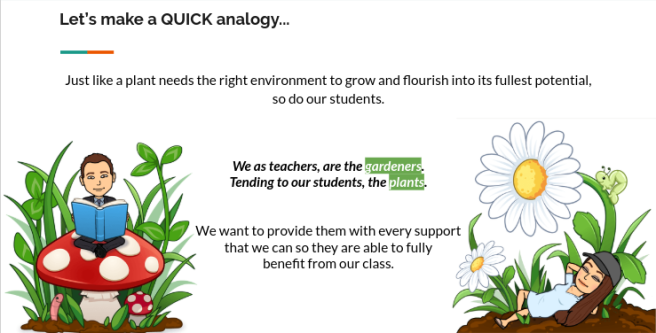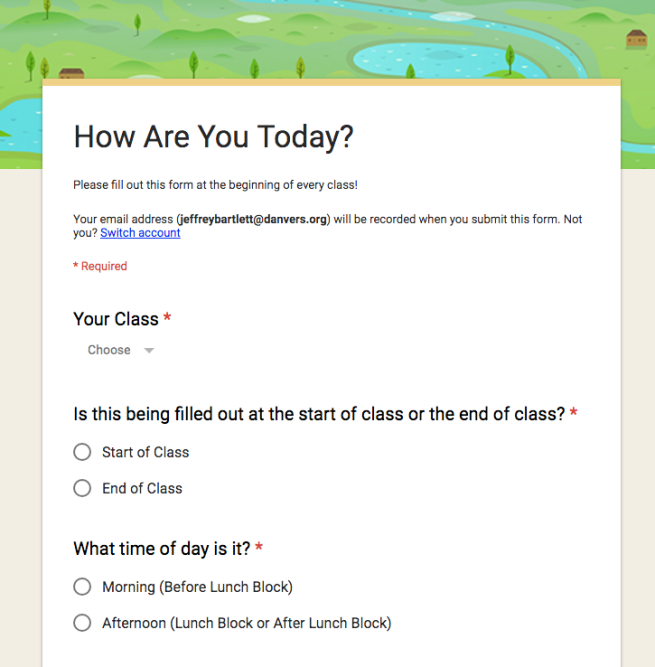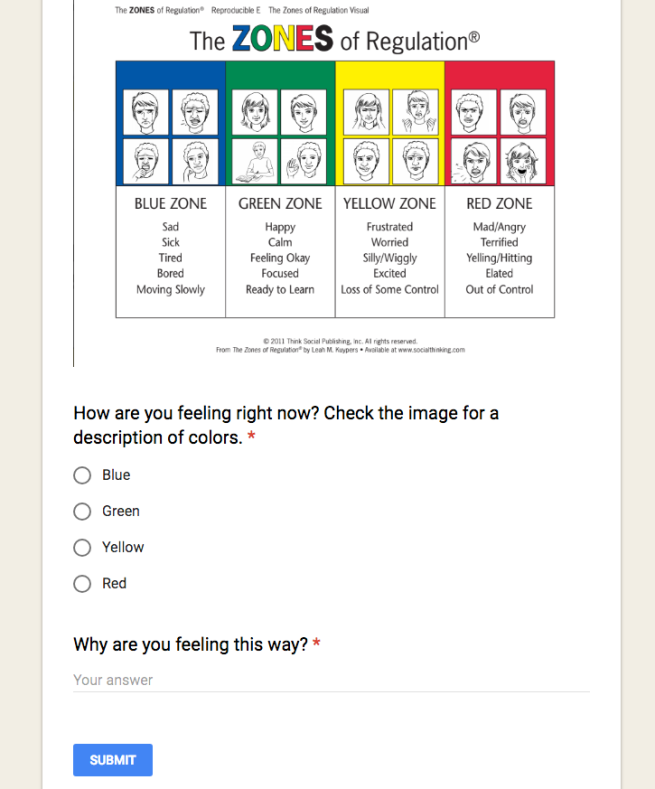Many educators in the fields of health and physical education can explain to you how the nature of their subject areas are natural fits for social emotional learning. I agree with those viewpoints, but I want to let it be known that I think ALL classrooms can be places where social emotional learning occurs. Experimenting within the competencies of social emotional learning is an experiment I’m undertaking this year. My main resource is the CASEL website and various pieces of information from the Essex County Learning Community that my district is a part of. I’m finding that you don’t need to be an expert in SEL to implement different aspects of it: you need to be a lifelong learner, have a growth mindset, and be willing to critically examine your own teaching practice.
Earlier this summer, Danielle and I presented at the MAHPERD Health Education Conference on social emotional strategies that help create a social emotional environment in a social emotional learning classroom. We know that SEL is a buzzword/phrase now, and that many districts are rolling out initiatives.
When planning our presentation, we came up with the analogy below and included it in our presentation, Bitmojis and all. I think it sums up why SEL is so important to implement in our daily practice as educators:

I might even start keeping a succulent on my desk at work as a reminder. I mean, I have a Bob Ross Chia Pet there, but it’s unplanted…anyway…I’ve been looking at SEL through many different angles: my work with Danielle from a classroom perspective, and my work with the ECLC and district strategic planning sessions at the district level. Either way, for me it comes down to a coordinated approach of what educators are doing to promote social emotional learning environments. My #healthed peeps know what I’m talking about; if we implement the WSCC Model then there’s a greater chance of SEL initiatives sticking. Now I’m rambling…
Social emotional learning can look different based on how it is implemented. CASEL is THE resource for those looking for more information on SEL. Today, I want to explain how I use daily check ins to promote multiple core competencies of SEL in my health education classroom: the competencies of self awareness and self management.
Before I continue I should mention that this is NOT a research based SEL curriculum or taught through explicit instruction, as SEL should be. This is simply me experimenting and figuring out what I need to adjust to promote SEL concepts within my classroom. I will be tweaking this approach during the year and adding to it, and my hope is to eventually infuse more into our instruction, because so much of a skills based health education curriculum directly links to the SEL competencies.
Taking the time to check in with your students is an important part of the daily routine of any teacher. I’m usually informal about this, but this year decided I wanted to gather some concrete data that I can use to modify and adjust my teaching. I’ve been experimenting with the Zones of Regulation. This is a concept (and a book) by Leah Kuypers. Technically it’s an entire curriculum, but I’m just pulling one piece from it. Teaching students about the zones means they are able to self regulate based on how they feel or their alertness level. More information can be found here. To make a long story short: there are four zones: blue, green, yellow, red. Each zone has characteristics associated with it.
I briefly introduced students to the Zones at the start of the school year. At the start of every class, students fill out a quick Google Form, selecting their current zone and providing an explanation as to why they feel they’re in that zone. I have ten separate classes over a two day cycle right now, so I’m gathering a lot of information. I quickly scan the responses on a Google Sheet (easily bookmarked on my Chromebook) as they complete the rest of the Do Now/Activator and I’m sending in attendance. Based on the information I see, I can tailor class activities to bring kids up or down into the green zone, or just keep an eye out on specific students. I might see the need to work on mindfulness for a few minutes or that students need a movement break, for example. Right now the focus is on building self-awareness and having students really check in with themselves and reflect on why they’re feeling the way they are. Building up the tools in my teacher’s toolbox is the next step for me.
I’ll also have a ton of data from throughout the year as I move forward with this. I’ve already noticed a pattern of students being more “green” after lunch or when they have classes that day they enjoy going to, based on their responses. My long term goal is to start to infuse strategies to help students self regulate, so if they know they’re in yellow, for example, they have resources at their disposal to help them. I’m creating a “Take a Break” corner that will (eventually) have different strategies tailored to each specific zone that students can use if they need to take some time to get themselves back into learning mode. I think this strategy works well with middle school students, and if it’s implemented in a more specific, sequential school wide way (as opposed to me just kind of playing by ear with it), that all teachers would see the benefits in their classrooms. I’d also be interested in having students fill out the form at the end of class after we engage in different activities, at least if there was a lot of red or yellow at the start, to see if there was a change.
This quick check in has allowed me to have positive interactions with students who might typically fly under the radar. Last week, a student who presented as a normal/typical student revealed she was in the “yellow” zone due to: an acapella group audition after school, on the same day she had to learn a part for jazz band, when she also had soccer practice after field hockey practice, on top of her regular homework and an art project that was due the next day. This information gave me something to check in with her about and to see if she needed any resources or help. I never would have known she was stressing because she presented so typically during class. Because her locker is in my hallway, I’ve been able to check in with her a few times since that initial check in (she was green at the latest check in). Today, another student expressed she was in the red zone, only because, “I’m in a bad mood just mad.” I was able to check in with her after class, but I was also able throw her a bone in class when she was frustrated with something she was working on and was hard on herself. These are just two examples, but there have been other instances, too. Students have been good about being honest, but I don’t pry for extra information. Explanations are only a sentence or so long. So far, the majority of check ins are green, with blue being second. There are definite trends emerging so far, and I’m curious to see what happens as the school year goes on.
So what does the form look like? It’s rather simple, and screenshots are below (I included the image of the zones from the book because it’s also available online, but I can take it off for this post if the authors want me to). The whole process does not take away from any instructional time, but even if it did, it’s worth it because this allows me the possibility to help all of my students during a block.


How do you use daily check ins in your classroom?
Categories: Classroom Social Emotional Learning
Hey Jeff, I love the check-in that you use with your students. Would it be possible to get a copy to use with my students for online learning?
LikeLike
Hi Ashley! Thanks for reading! I’ll share via your email. Stay tuned!
LikeLike
Awesome thanks so much!
LikeLike
Hey, do you think that I could get a copy of this as well? This is amazing!
LikeLike
Would I be able to get a copy as well?
LikeLike
Hi, Jeff! I would like a copy as well!
LikeLike
Would I be able to get a copy of this?
LikeLike
Is there a way to get a copy of this?
LikeLike
Hi!
Can you send me a copy of this? I love it!
LikeLike
Hi Jeff, I love your zones of regulation’s check in. I’d like to have a copy as possible. Would I be able to change where the email is sent to? I will have parent concerns is it it’s not being returned to me.
Thank you for your support, Pam at
Vlsocialthinking@gmail.com
LikeLike
Hi Jeff! Would you mind sharing your “Zones of Regulation” Google check-in? I would love to try this as the school year gets underway. Thanks so much!
LikeLike
Hello,
Can I get a copy of your Zones checkin for google forms?
LikeLike